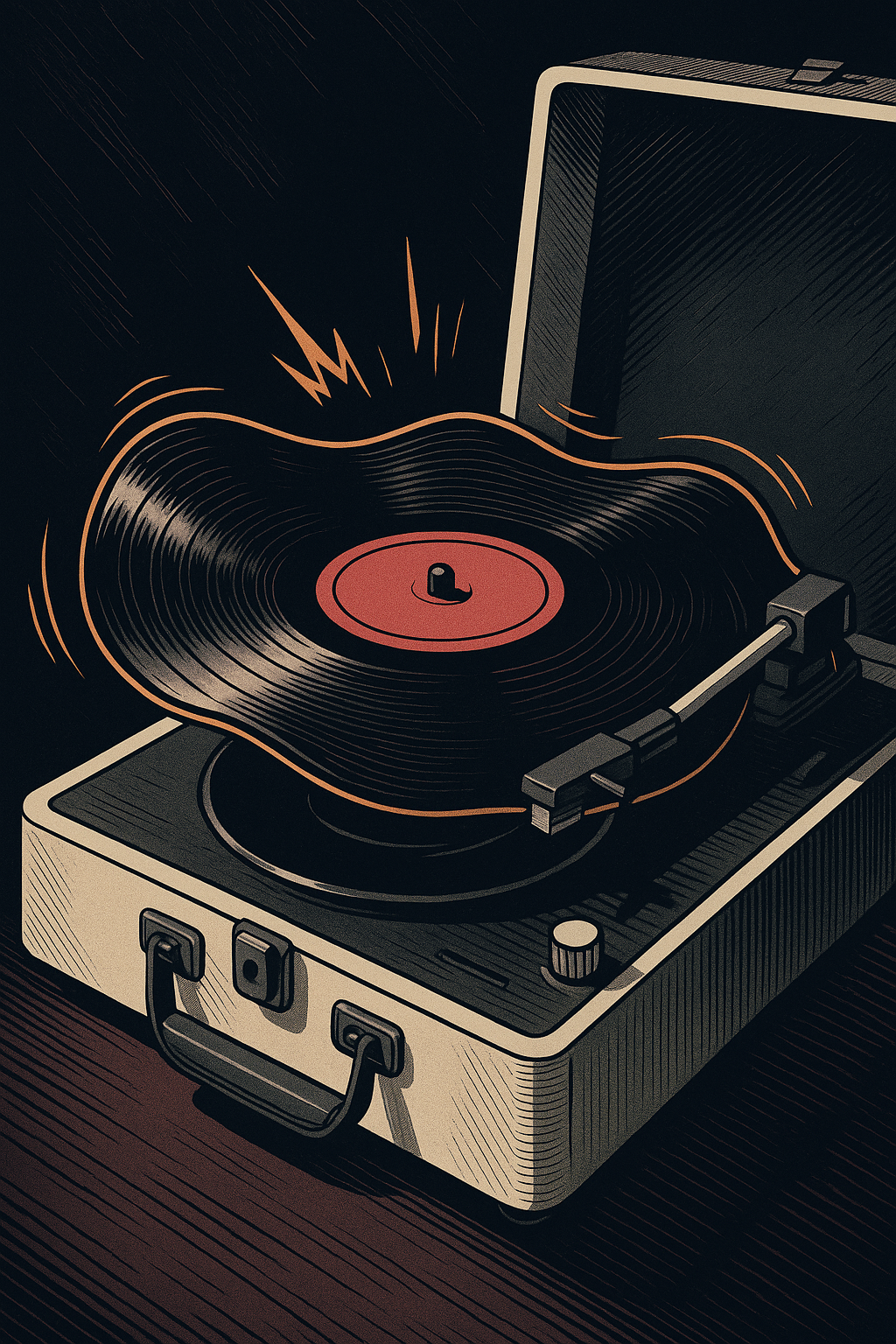So, you've decided to dip your toes into the wonderful world of vinyl. You're eyeing up record players, maybe you've even started flipping through crates at your local record store. But then you hit a fork in the road, a technical distinction that seems to pop up everywhere: belt drive versus direct drive. What does it mean? Is one inherently superior? And most importantly, which one is right for you as a beginner?
Fear not. While the debate can get surprisingly heated in audiophile circles, the fundamental concepts are straightforward. Understanding these two primary methods of spinning a record is a key piece of the puzzle in choosing your first (or next) turntable. It’s not just about arcane technicalities; it’s about how these design choices can impact sound, usability, and longevity.
The Heart of the Matter: Making the Platter Spin
At its simplest, a turntable needs to do one thing with unwavering precision: rotate a record at a consistent speed (typically 33⅓ or 45 revolutions per minute). The "drive system" is the mechanism that achieves this. The terms "belt drive" and "direct drive" refer to how the motor’s power is transferred to the platter – that heavy disc your record sits on.
Belt Drive: The Gentle Persuader
Imagine a simple, elegant solution: an electric motor sits offset from the platter, and a rubber belt, much like a sophisticated elastic band, loops around the motor’s spindle and the platter (or a sub-platter beneath it). When the motor turns, the belt pulls the platter along with it.
How it Works:
-
An independent motor unit.
-
An elastic belt connecting the motor pulley to the platter or sub-platter.
-
The motor spins, the belt transfers this motion, and the platter rotates.
The Theoretical Advantages (and Why Audiophiles Often Lean In):
-
Motor Isolation & Vibration Damping: This is the big one. The motor is a source of mechanical vibration and potential electrical noise. By physically decoupling the motor from the platter with an elastic belt, much of this unwanted vibration can be absorbed and prevented from reaching the stylus. The stylus is incredibly sensitive – its job is to read microscopic variations in the record groove. Less extraneous vibration should mean a cleaner signal, a lower noise floor, and thus, more music.
-
Simplicity of Design (Potentially): In many implementations, the core mechanics can be quite straightforward, which can be a virtue.
Potential Considerations:
-
Belt Wear and Tear: Belts are consumable. They stretch, dry out, and eventually need replacing. An old, worn, or incorrect belt can lead to speed inaccuracies (wow and flutter).
-
Startup Speed: Belt drive turntables typically take a few seconds to get up to the correct speed as the belt takes up the slack and stabilizes the platter’s momentum. This is rarely an issue for home listening but noticeable if you're used to instant-on digital sources.
-
Speed Consistency: While the belt isolates, it can also, if not perfectly implemented or if the belt itself isn't high quality, introduce slight speed variations. Higher-end belt drive systems employ sophisticated motors, power supplies, and precisely machined platters and belts to mitigate this.
Where You'll Find Them: Predominantly in turntables designed for home audio listening, from budget-friendly entry-level models to cost-no-object audiophile titans. The design philosophy prioritizes sonic purity through isolation.
Direct Drive: The Precision Powerhouse
Now, picture a different approach: the platter sits directly on top of the motor’s spindle. There are no belts; the motor itself is the direct source of rotation for the platter.
How it Works:
-
The platter is an integral part of the motor assembly or is directly coupled to it.
-
Sophisticated motor control systems are often used to ensure precise speed.
The Theoretical Advantages (and Why DJs and Some Audiophiles Swear By Them):
-
Speed Accuracy & Stability: A well-engineered direct drive system can offer exceptionally precise and unwavering speed. Because the motor is directly coupled, there's no belt to stretch or slip. This results in very low wow and flutter.
-
Quick Startup & Torque: Direct drive turntables get up to speed almost instantly and often have higher torque (rotational force). This is essential for DJs who need to cue records quickly, but it's also satisfying for home users.
-
Durability & Lower Maintenance (for the drive system): No belts to replace means one less maintenance item to worry about. The motors themselves are often very robust.
Potential Considerations:
-
Motor Noise Transmission: This is the historical Achilles' heel of direct drive. Because the motor is directly connected to the platter, any vibration or "cogging" (slight rotational pulsations in some motor designs) from the motor could be transmitted to the platter and, consequently, to the stylus. However, it's crucial to note that modern direct drive designs, especially in quality turntables, have made enormous strides in minimizing this through advanced motor technology, sophisticated control circuitry, and plinth damping. The idea that all direct drives are inherently noisy is an outdated generalization. Reputable sources like Wikipedia's entry on Turntable Design offer more technical background on these motor types.
Where You'll Find Them: Ubiquitous in the DJ world (think the legendary Technics SL-1200 series). Also found in many high-quality Japanese turntables from brands like Denon, Audio-Technica, and, yes, Technics, who produce excellent direct drive models for audiophile listening. There's a growing resurgence in high-end audiophile direct drive designs as well.
So, Which is "Better" for a Beginner? The Million-Dollar Question (That Isn't)
Here’s the truth: neither drive system is universally "better" for a beginner. The "best" choice depends on your priorities, your budget, and how you intend to use your turntable.
-
If your primary goal is pure, sit-down-and-listen audiophile experience, and you're drawn to the idea of maximum isolation: A good quality belt drive turntable is often the traditional recommendation. The inherent design can offer a very smooth and musical presentation.
-
If you value rock-solid speed stability, quick start-up, and potentially lower drive system maintenance (no belts): A modern, well-made direct drive turntable can be an excellent choice. Don't let outdated fears of motor noise scare you off from quality contemporary designs.
-
Are you considering DJing, even casually? Then direct drive is almost certainly the way to go due to its torque and durability under manual manipulation (like scratching or back-cueing).
The Most Important Factor: Overall Build Quality and Synergy
More crucial than the drive type alone is the overall quality of the turntable's construction and the synergy of its components. A poorly designed belt drive with a cheap motor and a flimsy plinth will likely sound worse than a well-engineered direct drive with excellent motor control and a robust chassis, and vice-versa.
Consider:
-
Tonearm Quality: A good tonearm allows the cartridge to track the groove accurately with minimal friction.
-
Cartridge Quality: The cartridge (and its stylus) is what actually reads the record. This is a huge factor in the sound.
-
Plinth Construction: The base of the turntable. A heavy, well-damped plinth helps to reduce unwanted resonances.
-
Phono Preamplifier: Whether built-in or external, a good phono stage is essential to properly amplify the tiny signal from the cartridge.
A truly great listening experience, such as the kind we aim to facilitate at XJ-HOME (https://xenonjade.com) through thoughtful component selection and system matching, comes from a holistic approach, not just one specific feature.
Beyond the Drive: Don't Sweat It Too Much Initially
For a beginner, getting bogged down in the belt vs. direct drive debate can lead to "analysis paralysis." Many excellent entry-level to mid-range turntables exist in both categories. Reading reviews, and if possible, listening to different models can be far more instructive.
The key is to find a turntable that is well-made for its price point, easy to set up and use, and treats your records with care. Whether it's belt-driven or direct-driven is just one part of that equation. As you delve deeper into the hobby, you’ll develop your own preferences and understanding of how these different engineering approaches translate into the listening experience.
Ultimately, the goal is to get you listening to and enjoying your vinyl collection. Both belt drive and direct drive turntables can help you do just that, beautifully.





Leave a comment
All comments are moderated before being published.
This site is protected by hCaptcha and the hCaptcha Privacy Policy and Terms of Service apply.